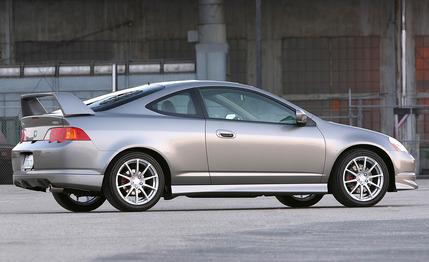 Short Take Road Test
Short Take Road Test
Honda and Acura are gearing up to cash in on the growing compact-hot-rod market. Now buyers of Acura's sporty $23,670 hatchback, the RSX Type-S, can opt for the Honda-developed-and-produced, dealer-installed $5360 Factory Performance package that includes stiffer springs and shocks, new wheels and tires, and a body package.
A "compact" hot rod is any souped-up car that has front-wheel drive and a four-cylinder engine. The Specialty Equipment Market Association, a group that tracks the aftermarket industry, estimates that the compact-performance market is worth $1.5 billion a year, so who could blame Honda and Acura for grabbing a slice of it?
Last spring, Honda offered the first Factory Performance package, on the current-generation Honda Civic. For 2003, it's expanded Factory Performance (FP) to include kits for the Honda Civic coupe, the Accord coupe with the V-6 and six-speed manual transmission, and the Acura RSX Type-S.
Since the FP package competes with wares from numerous aftermarket companies, Acura is cagey about some FP details. For example, it will only say that the FP springs and struts are stiffer, not how much stiffer. The springs are shorter by an inch, which lowers the car by the same amount. The 17-inch FP wheels are 7.5 inches wide and accommodate Yokohama AVS ES100 225/45ZR-17 tires (the stock tires are 205/55VR-16s).
We compared the FP car with a plain-Jane RSX Type-S in two handling tests. The FP car pulled 0.88 g on the skidpad, compared with 0.83 g for the standard car. In the emergency-lane-change maneuver, the FP car sliced through the cones at an average speed of 62.5 mph versus 58.9 mph for the Type-S.
The FP car certainly feels more aggressive. It turns in crisply and, as the numbers suggest, digs in harder and with less body lean. Although we wouldn't call the ride quality harsh, it is on the stiff side, especially when traversing the frost heaves that plague our Midwestern highways.
Also included with the kit are front and rear slotted brake rotors that are the same size as the regular pieces, and brake pads that have more bite. Since tire traction predominantly determines braking performance, we think the stickier tires and their larger contact patches probably account for the FP car's 175-foot stop from 70 mph-an improvement of 21 feet over the stocker. Brake-pedal feel was about the same between the two.
Since the FP package does not include any modifications to the 200-hp four, we expected the top speed and acceleration times of the two cars to be about the same. If anything, we expected the large rear wing and front air dam on the FP to increase drag and lower top speed, but on the high-banked oval, our test car climbed to 142 mph-3 mph more than the stocker. Credit the lowered suspension for reducing frontal area and underbody airflow, and a secondary chin spoiler that further smoothes underbody airflow.
In fact, those aero mods may be worth even more miles per hour at the top end, because at the drag strip, our FP car behaved as though its engine were still a bit green. Despite weighing 98 pounds less than the stock car, it took 6.8 seconds to reach 60 mph-half a second longer than the stock car needed. It cleared the quarter in 15.4 seconds at 93 mph, 0.4 second and 1 mph off the pace of our stocker. Clearly, the FP test car's engine was a tad soft.
Two more things: Our base price for the FP includes an estimated $560 labor charge because you have to pay the dealer to install the package. Acura estimates it takes eight hours, but time and flat-rate costs may fluctuate. Also, you can't buy the parts individually because Honda and Acura don't want some schmo buying a shift knob and calling his car an FP.
And if you think you could make your own less-expensive version of the FP by buying el-cheapo bits and putting them on and painting them yourself, we're willing to bet on three things: (1) You'd have spent close to the same money. (2) You'd spend months getting everything to fit properly. (3) The finished product probably wouldn't come close to the factory feel and appearance of our test car. Also, consider this: The FP parts are covered by Acura's four-year/50,000-mile warranty.
Although we appreciate that Acura is offering the option of a pimped look to your RSX while gaining some extra performance, it's a little hard to fathom a nearly $30,000 RSX, especially when a few grand more will get you into a 240-hp Honda S2000 roadster.